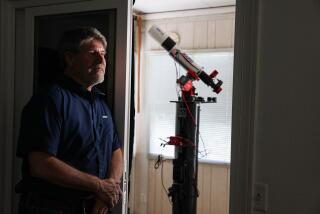From old-fashion to high-tech, star maps tested
The moon is that big silvery object in the night sky, and the sun is that bright glowing orb that is responsible for all life on this planet. If that’s the extent of your astronomical knowledge, you might consider buying a device to identify more heavenly objects. We tested several tools, from high-tech GPS-guided gadgets to old-fashioned cardboard sky charts, to see which does the best job of putting names to those twinkly lights in the night sky.
TALK OF THE TOWN

First look: Celestron, maker of telescopes, binoculars and microscopes, offers the Skyscout, a device the size of a hand-held camcorder. Look through the lens at an object in the night sky, push a button and the Skyscout tells you what you are seeing, through earphones or in a text message on a digital screen. The device uses GPS technology and Earth’s magnetic field and gravitational pull to gauge where you are and what you are looking at. If you want to see a particular object, such as Jupiter, arrows around the lens can also point you toward your target.
Likes and yikes: The Skyscout is so intuitive that we had an 8-year-old kid wielding it like a pro, pointing out constellations and planets with ease. Celestron claims it can identify 6,000 skyward objects. The only minor drawback is that the lens takes in a huge chunk of sky, rather than zeroing in on a pinpoint of light.
411: $399, available at Brookstone, Sharper Image and REI stores, or call (310) 328-9560, or go to www.celestron.com.
ON A SCREEN NEAR YOU

First look: Meade, another manufacturer of telescopes, binoculars and microscopes, recently introduced a rival to the Skyscout, the mySKY, a hand-held device about the size and shape of a power drill. Like the Skyscout, mySKY identifies stars, constellations and other objects in the sky. But instead of a lens, mySky has a 2 1/2 -inch screen (measured on the diagonal) that shows the patch of sky in your sights. Pull the trigger on this gun-shaped tool and a voice from the earphones tells you what you are looking at. Like the Skyscout, mySKY can also direct you, using an arrow on the screen, toward stars and planets you want to spot.
Likes and yikes: The advantage of mySKY is that the screen displays a bright, colored depiction of the sky, a plus when your view is blocked by clouds, trees or other obstacles. Meade claims mySKY can identify 30,000 objects. The drawback: It can take 10 minutes or more for the GPS receiver to communicate with orbiting satellites.
The 411: $399, available at Samy’s Camera, Woodland Hills Camera & Telescopes, or call (949) 451-1450, or go to www.meade.com to find a local retailer.
AN OLD FAVORITE

First look: The Stellarscope is a French-made plastic tube that looks like a short monocular. Turn the rotating cylinders to align the time and date and hold the scope vertically with the “E” and “W” symbols pointed East and West, respectively. Look through the lens and see a star map with the brightest stars and constellations identified by name.
Likes and yikes: The Stellarscope is basically a star chart that you see through a plastic scope. Still, it’s a fun little device that kids might like on camping trips. Because planets are in orbit, you won’t see them marked on the Stellarscope chart.
The 411: $40, available at Hammacher Schlemmer, (800) 321-1484 or www.hammacher.com.
BETTER THAN CINEMASCOPE

First look: For those who want to identify the celestial bodies the old-fashioned way, a simple cardboard star guide, also known as a planisphere, does the trick without batteries or microcircuitry. Such guides consist of two overlapping disks. Once you rotate the disks to mark the proper time and date, you see a sky map, with stars and constellations identified in tiny print.
Likes and yikes: The obvious limitation to sky guides is that they can show only the brightest stars and constellations, and you have to do the work of matching what you see on the map with the lights in the sky. The advantage: easy to carry, never runs out of juice and some versions glow in the dark.
The 411: $7.50 to $20, depending on the quality. Available at most telescope shops and at www.skymaps.com.
More to Read
Sign up for The Wild
We’ll help you find the best places to hike, bike and run, as well as the perfect silent spots for meditation and yoga.
You may occasionally receive promotional content from the Los Angeles Times.






